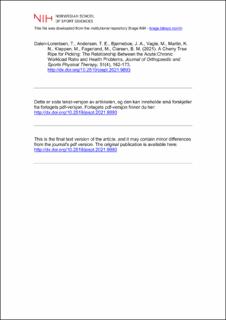| dc.contributor.author | Dalen-Lorentsen, Torstein | |
| dc.contributor.author | Andersen, Thor Einar | |
| dc.contributor.author | Bjørneboe, John Andreas | |
| dc.contributor.author | Vagle, Markus | |
| dc.contributor.author | Martin, Kevin Nordanger | |
| dc.contributor.author | Kleppen, Michael | |
| dc.contributor.author | Fagerland, Morten | |
| dc.contributor.author | Clarsen, Benjamin Matthew | |
| dc.date.accessioned | 2024-03-19T09:15:28Z | |
| dc.date.available | 2024-03-19T09:15:28Z | |
| dc.date.created | 2021-03-31T10:49:38Z | |
| dc.date.issued | 2021 | |
| dc.identifier.citation | Journal of Orthopaedic and Sports Physical Therapy. 2021, 51(4), 162-173. | en_US |
| dc.identifier.issn | 0190-6011 | |
| dc.identifier.uri | https://hdl.handle.net/11250/3123027 | |
| dc.description | I Brage finner du siste tekst-versjon av artikkelen, og den kan inneholde ubetydelige forskjeller fra forlagets pdf-versjon. Forlagets pdf-versjon finner du på www.jospt.org / In Brage you'll find the final text version of the article, and it may contain insignificant differences from the journal's pdf version. The original publication is available at www.jospt.org | en_US |
| dc.description.abstract | Objective: To investigate whether the relationship between the acute-chronic workload ratio (ACWR) and health problems varies when different methodological approaches are used to quantify it. Design: Prospective cohort study. Methods: An online questionnaire was used to collect daily health and training information from 86 elite youth footballers for 105 days. The relationship between players' training load and health was analyzed using a range of different definitions of ACWR and health problems. We used 21-day and 28-day chronic periods, coupled and uncoupled calculations, and the exponentially weighted moving average and rolling average. Acute-chronic workload ratio data were categorized as low, medium, or high, using predefined categories and z scores. We compared medium to high, medium to low, and low to high categories. The outcome was defined in 3 ways: “all health problems,” “all injuries,” and “new noncontact injuries.” We performed random-effects logistic regression analyses of all combinations, for a total of 108 analyses. Results: We recorded 6250 athlete-days and 196 health problems. Of the 108 analyses performed, 23 (21%) identified a statistically significant (P<.05) association between the ACWR and health problems. A greater proportion of significant associations were identified when using an exponentially weighted moving average (44% of analyses), when comparing low to high categories (33%), and when using the “all health problems” definition (33%). Conclusion: The relationship between the ACWR and health problems was dependent on methodological approach. | en_US |
| dc.language.iso | eng | en_US |
| dc.subject | ACWR | en_US |
| dc.subject | football | en_US |
| dc.subject | injury | en_US |
| dc.subject | training load | en_US |
| dc.title | A cherry, ripe for picking: The relationship between the acute-chronic workload ratio and health problems | en_US |
| dc.title.alternative | A Cherry, Ripe for Picking: The Relationship Between the Acute-Chronic Workload Ratio and Health Problems | en_US |
| dc.type | Peer reviewed | en_US |
| dc.type | Journal article | en_US |
| dc.description.version | acceptedVersion | en_US |
| dc.source.pagenumber | 162-173 | en_US |
| dc.source.volume | 51 | en_US |
| dc.source.journal | Journal of Orthopaedic and Sports Physical Therapy | en_US |
| dc.source.issue | 4 | en_US |
| dc.identifier.doi | 10.2519/jospt.2021.9893 | |
| dc.identifier.cristin | 1901811 | |
| dc.description.localcode | Institutt for idrettsmedisinske fag / Department of Sports Medicine | en_US |
| cristin.ispublished | true | |
| cristin.fulltext | postprint | |
| cristin.qualitycode | 1 | |
